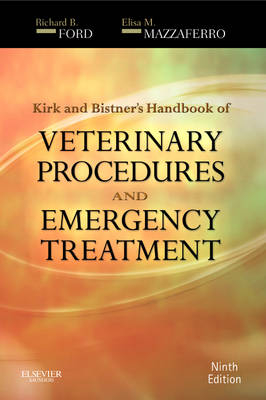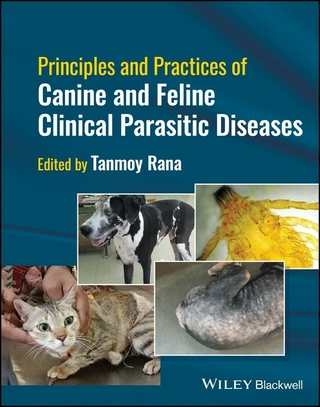
Kirk & Bistner's Handbook of Veterinary Procedures and Emergency Treatment
W B Saunders Co Ltd (Verlag)
978-1-4377-0798-4 (ISBN)
Provide expert care for cats and dogs! Kirk and Bistner's Handbook of Veterinary Procedures and Emergency Treatment, 9th Edition covers not only the management of emergency conditions, but also strategies for dealing with hundreds of routine diagnostic and treatment challenges in small animals. Its user-friendly format provides instant access to vital information -- making it an ideal resource in emergency situations -- and it is conveniently organized by both body systems and presenting signs to help you easily reach a diagnosis and determine a treatment plan for all clinical situations. Written by veterinary experts Richard Ford and Elisa Mazzaferro, Kirk and Bistner's Handbook of Veterinary Procedures and Emergency Treatment provides current guidelines for small animal emergency care and the diagnostic procedures most commonly performed in a busy, team-oriented practice.
Step-by-step instructions and illustrations are provided for all major emergency and non-emergency clinical procedures.
A logical, easy-to-use format lists all emergency conditions in alphabetical order, and includes quick reference boxes calling out key information such as clinical tips and cautions.
Clear, concise guidelines help you evaluate clinical signs and laboratory test data.
Clinical algorithms make it easier to identify and treat abnormalities.
Guidelines for assessment and treatment include practical advice and solutions, how to examine the small animal patient using a body systems and problem list approach, and a review of basic diagnostic procedures used in daily practice.
Coverage of toxicological emergencies describes how to manage exposures and poisonings.
A quick reference guide to the management of the emergency patient is conveniently located on the inside cover.
A comprehensive drug formulary makes lookup easy, and includes proprietary names, actions/use of each drug, formulations, recommended dosages, and special precautions, with emergency medications highlighted for fast reference
This all-in-one reference includes practical coverage of emergency procedures, physical assessment in sickness and health, routine and advanced testing procedures, diagnostic tests sampling, preparation, procedures, and interpretation.
Quick Reference boxes include potential causes of each clinical abnormality and associated signs, step-by-step diagnostic plans, and clinical algorithms.
The latest vaccination guidelines include protocols for dogs and cats at low, medium, and high risk of exposure to infectious diseases.
Updated coverage keeps you current with the latest on pain assessment, prevention, and treatment.
Section 1: Emergency Care
Prehospital management of the injured animal
Initial emergency examination, management, and triage
Emergency diagnostic and therapeutic procedures
Pain: assessment, prevention, and management
Emergency management of specific conditions
Section 2: Patient Evaluation and Organ System Examination
Patient evaluation
The medical record
The organ system examination
Section 3: Clinical Signs
Abdominal enlargement with ascites
Abdominal enlargement without ascites
Aggression
Alopecia (See hair loss)
Ataxia (See incoordination)
Blindness (See vision loss)
Blood in urine: hematuria, hemoglobinuria, myoglobinuria
Coma: loss of consciousness
Constipation (obstipation)
Cough
Coughing blood: hemoptysis
Deafness or hearing loss
Decreased urine production: oliguria and anuria
Diarrhea, acute-onset
Diarrhea, chronic
Difficulty breathing or respiratory distress: cyanosis
Difficulty breathing or respiratory distress: dyspnea
Difficulty swallowing: dysphagia
Hair loss: alopecia
Hemorrhage (See spontaneous bleeding)
Icterus (See yellow skin)
Incoordination: ataxia
Increased urination and water consumption: polyuria and polydipsia
Itching or scratching: pruritus
Jaundice (See yellow skin)
Joint swelling: arthropathy
Loss of appetite: anorexia
Lymph node enlargement: lymphadenomegaly
Pain
Painful urination: dysuria (See straining to urinate)
Painful defecation: dyschezia (See straining to defecate)
Rectal and anal pain (See straining to defecate)
Regurgitation
Seizures (convulsions or epilepsy)
Sneezing and nasal discharge
Spontaneous bleeding: hemorrhage
Straining to defecate: dyschezia
Straining to urinate: dysuria
Swelling of the limbs: peripheral edema
Uncontrolled urination: urinary incontinence
Vision loss: total blindness
Vomiting
Vomiting blood: hematemesis
Weakness, lethargy, fatigue
Weight loss: emaciation, cachexia
Yellow skin or mucous membranes: icterus (or jaundice)
Section 4: Diagnostic and Therapeutic Procedures
Routine Procedures
Dermatologic Procedures
Advanced Procedures
Section 5: Laboratory Diagnosis and Test Protocols
Common reference range values
Sample handling
Submission requirements for rabies suspects
Histopathology and cytopathology
Biochemistry--routine
Routine biochemical testing
Special diagnostic tests and test protocols
Hemostasis and coagulation
Endocrinology
Immunology
Infectious disease serology and microbiology
Urine
Section 6: Charts and Tables
6-1: Emergency Hotlines
6-2: Dog Breeds Recognized by the American Kennel Club (AKC)
6-3: Cat Breeds Recognized by the Cat Fanciers' Association (CFA)
6-4: Useful Information for Rodents and Rabbits
6-5: Determination of the Sex of Mature and Immature Rodents and Rabbits
6-6: Blood Values and Serum Chemical Constituents for Rodents and Rabbits
6-7: Ferrets--Physiologic, Anatomic, and Reproductive Data
6-8: Hematologic Values for Normal Ferrets
6-9: Serum Chemistry Values for Normal Ferrets
6-10: Electrocardiographic Data for Normal Ferrets
6-11: Conversion of Body Weight in Kilograms to Body Surface Area in Meters Squared for Dogs
6-12: Conversion of Body Weight in Kilograms to Body Surface Area in Meters Squared for Cats
6-13: French Scale Conversion Table
6-14: International System of Units (SI) Conversion Guide
6-15: Units of Length, Volume, and Mass in the Metric System
6-16: Vaccines Licensed for Use in Dogs in the United States
6-17: Vaccines Licensed for Use in Cats in the United States
6-18: Canine Vaccination Recommendations-Initial Puppy Series
6-19: Canine Vaccination Recommendations-Adult
6-20: Feline Vaccination Recommendations-Initial Kitten Series
6-21: Feline Vaccination Recommendations-Adult
6-22: Compendium of Animal Rabies Prevention and Control, 2005, National Association of State Public Health Veterinarians, Inc. (NASPHV)
6-23: Prescription Writing Reference... Do's and Don'ts
6-24: Common Drug Indications and Dosages
| Erscheint lt. Verlag | 20.9.2011 |
|---|---|
| Zusatzinfo | Approx. 165 illustrations; Illustrations |
| Verlagsort | London |
| Sprache | englisch |
| Maße | 152 x 229 mm |
| Gewicht | 980 g |
| Themenwelt | Veterinärmedizin ► Klinische Fächer |
| ISBN-10 | 1-4377-0798-X / 143770798X |
| ISBN-13 | 978-1-4377-0798-4 / 9781437707984 |
| Zustand | Neuware |
| Haben Sie eine Frage zum Produkt? |
aus dem Bereich


